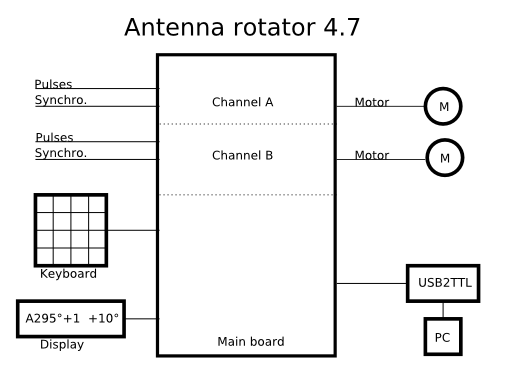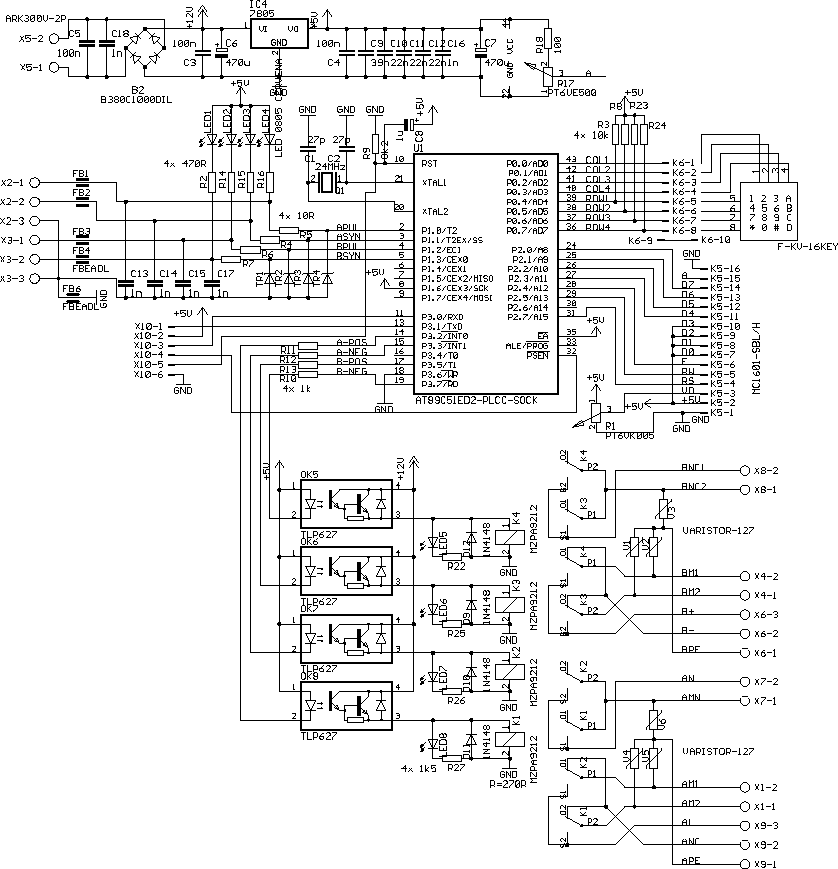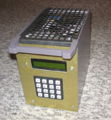Rotar47: Difference between revisions
No edit summary |
|||
| Line 1: | Line 1: | ||
=Antenna rotator 4.7= | =Antenna rotator 4.7= | ||
Rotar is digitally controlled antenna rotator. It can drive DC commutator motors, AC 2-phase motors or linear motor (superjack) for elevation. It has | Rotar is digitally controlled antenna rotator. It can drive DC commutator motors, AC 2-phase motors or linear motor (superjack) for elevation. It has two independent channels so it can drive two azimutal motors or one azimutal and one elevation motor. Sensors are magnetical contact providing pulses. Each channel has two contacts - one for pulses and second for synchronization. Human control is done by matrix keyboard 4x4 and HD44780 compatible display. It can communicate with PC via TTL-level serial port. Available accessories is [[Usb2ttl|USB converter]] for control using [[Main_Page|Tucnak]]. | ||
[[Image:Rotar47.png|none|frame|Principe of rotator 4.7]] | [[Image:Rotar47.png|none|frame|Principe of rotator 4.7]] | ||
| Line 24: | Line 24: | ||
</gallery> | </gallery> | ||
Note: 600 DPI have images in Full resolution, MediaWiki uses thumbnails. | Note: 600 DPI have images in Full resolution, MediaWiki uses thumbnails. | ||
=Sensors= | |||
Typical sensor consists of two contacts. They switching "live" wire to ground. | |||
==Pulses contact== | |||
It generates pulses depended of antenna rotation. Pulses does not depend on rotation direction. Direction is taken from polarity of motor drive. | |||
We use various resolution from 480 to 1060 pulses per 360 degrees. Length of ON and OFF time must be longer than about 2 ms (state is sampled by timer with period 480 Hz). So good idea is to have pulse ratio 1:1. | |||
Typically we use magnet glued on applicable whell in gear. In gears with no space and/or magnetic wheel we used optical sensor. But be aware of RFI if electronics circuit of sensor is near to antenna. | |||
==Synchronization contact== | |||
Pulses can be lost. So there is synchronization contact at known angle. When this contact is switched on, the rotator is synchronized to the known angle. Switch-on angles are two. First from positive, second for negative direction. Good ide is to have known synchronization angle in direction where operator beams antenna often. | |||
We use magnet on the mast or lobe with switch. | |||
Revision as of 08:51, 22 March 2009
Antenna rotator 4.7
Rotar is digitally controlled antenna rotator. It can drive DC commutator motors, AC 2-phase motors or linear motor (superjack) for elevation. It has two independent channels so it can drive two azimutal motors or one azimutal and one elevation motor. Sensors are magnetical contact providing pulses. Each channel has two contacts - one for pulses and second for synchronization. Human control is done by matrix keyboard 4x4 and HD44780 compatible display. It can communicate with PC via TTL-level serial port. Available accessories is USB converter for control using Tucnak.

Gallery
-
Control box made by OK1USW
-
Front view display and keyboard
-
Back panel with connectors
-
Finished board
Circuit diagram

PCB
-
PCB top side (600 DPI)
-
PCB bottom side (600 DPI)
-
Components placement top
-
Components placement bottom
Note: 600 DPI have images in Full resolution, MediaWiki uses thumbnails.
Sensors
Typical sensor consists of two contacts. They switching "live" wire to ground.
Pulses contact
It generates pulses depended of antenna rotation. Pulses does not depend on rotation direction. Direction is taken from polarity of motor drive.
We use various resolution from 480 to 1060 pulses per 360 degrees. Length of ON and OFF time must be longer than about 2 ms (state is sampled by timer with period 480 Hz). So good idea is to have pulse ratio 1:1.
Typically we use magnet glued on applicable whell in gear. In gears with no space and/or magnetic wheel we used optical sensor. But be aware of RFI if electronics circuit of sensor is near to antenna.
Synchronization contact
Pulses can be lost. So there is synchronization contact at known angle. When this contact is switched on, the rotator is synchronized to the known angle. Switch-on angles are two. First from positive, second for negative direction. Good ide is to have known synchronization angle in direction where operator beams antenna often.
We use magnet on the mast or lobe with switch.







